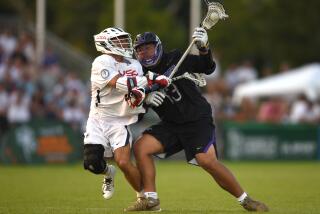<i> DI LAS KA</i> : This Game, Still a Favorite Among Cherokee Indians, Is Much Older Than Football, Baseball or Basketball
- Share via
TSA-LA-GI VILLAGE, Okla. — Hit-the-fish-on-top-of-the-pole is the most popular game of the 60,000 Cherokee Indians living in Oklahoma’s 14 eastern counties.
It’s an ancient game. No one knows when it started.
Today in the Cherokee Nation children play the game, men play against men, men against women, communities challenge communities.
Di Las Ka, as the Cherokees call the game, is a spinoff of stickball, perhaps the oldest sport in North America.
Nearly all Indians played some form of stickball dating back centuries before Columbus. Lacrosse traces its roots to Indian stickball.
Stickball for the early Indians was as much a mystic ceremony as a sport. It involved complex rituals, and one game often lasted several days.
Sometimes hundreds of warriors from one tribe would play hundreds of warriors from another tribe. Goals could be miles apart.
Like football, Indian stickball has two goals. Points are scored when a ball is hurled from a stick into the goal.
The Cherokee version of the historic game is different, though. It doesn’t have goals.
It has in the center of a playing field a 25-foot-high pole topped by a foot-high, foot-and-a-half-long carved fish.
“Fish is the Cherokee symbol for fertility but exactly why a fish is on top of the pole no one seems to know,” said Robert Dry, 32, one of the game’s top players.
The stick used in the Cherokee game somewhat resembles a tennis racket. It’s a 2 1/2-foot hickory stick with a 4-inch long, 3-inch wide opening, similar to an enlarged eye of a needle, at the end. Deer or squirrel sinew webbing is stretched across the eye, forming a small racket head.
In another variation, each player carries two sticks, one in each hand, to catch and throw a ball made of deer hair wrapped in deer or squirrel skin, a ball smaller than a tennis ball and bigger than a golf ball. In traditional Indian stickball and lacrosse, a player uses only one stick.
Teammates toss the ball to one another until one player is open and hurls the ball into the air with both sticks in the direction of the fish. If he hits the fish, his team scores four points.
If he hits the pole within two feet of the fish, he scores a point.
When Cherokee boys play girls and men play women, the males use sticks and the females use their hands to make the game more competitive.
“By not having to use sticks it gives us a chance to beat the men and we often do,” said Julie Moss, 28, a well-known player from Talequah, Okla.
Generally a half dozen to a dozen players are on each side, although more or fewer may play. The game is over when an agreed-to score is reached or within a specified time limit.
“In the old days, medicine men coached each team and prayed for the team’s success before each game,” Dry said. “If the team did not do too well, medicine men, like modern day coaches, were fired and new ones hired.”
It was an extremely rough game in the past. Cherokees called it “the little brother of war” because it prepared warriors for combat.
“It was not unusual for opposing players to break one another’s arms and legs with the sticks,” Dry said. “Sometimes a player would lose his life in a game. The competition was that fierce.”
In the past hit-the-fish-on-top-of-the-pole would be played to settle disputes between communities.
In the early days, when men from one village played against men from another village, players were forbidden contact with women for seven days before the game.
Certain foods, such as rabbit and frog, could not be eaten during the week before the game. It was believed those foods would make players timid and weak when competing against opponents.
Hit-the-fish-on-top-of-the-pole is an American game much older than baseball, football or basketball but unless you happen to be in Oklahoma’s Cherokee country you’ll probably never see it played.
More to Read
Sign up for Essential California
The most important California stories and recommendations in your inbox every morning.
You may occasionally receive promotional content from the Los Angeles Times.













